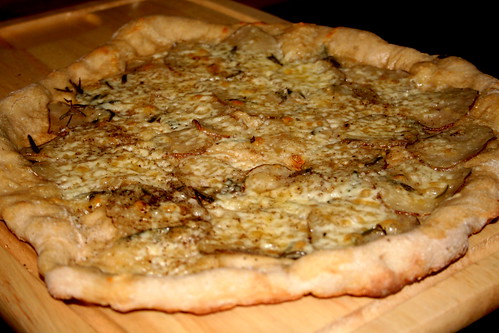
I've been relying on Antimo Caputo tipo 00 flour, a flour famous for its elasticity. Because of its high gluten content, it's an ideal pizza-making flour. After a few packages that just didn't seem particularly fresh, however, I took a break from the Caputo flour to try a few others. Frankly, though the date on the Caputo flour didn't suggest it was problematically old, there was a significant amount of clumping and a slightly metalic smell that put me off. There are many reasons why we're drawn to local products, and one is certainly freshness. As we turn from factory-farmed meats and vegetables, we re-encounter remarkable heirloom fruits and vegetables, revel in the amazing color and flavor of local eggs, and rediscover great flavors in meat from locally-raised animals. Why not flour?
On a recent night, we had over several friends to share wine and conversation, as well as to get some feedback on different types of flour. In addition to the eight of us, my 13-year old daughter had several friends over for a sleepover. Making pizza for twelve, including two vegetarians, gave me the opportunity to work through some key variations.
I used three types of flour. For my local flour, I chose an all-purpose organic unbleached flour from Westwind Mills, from Linden MI. For a truer pizza flour, instead of the Caputo flour I went with a King Arthur rendition that they compare to "tipo 00" and call an Italian-style flour. And for run-of-the-mill, I went with the standard King Arthur all-purpose flour.
I varied the toppings a bit, but tried to keep a baseline for comparison. I made margherita pizzas with buffalo mozzarella for the main point of comparison. Of course that worked for both vegetarians and meat-eaters. For the next round of pizzas, I did two: one was the classic Italian thinly sliced potatoes (local and organic, of course) with Fontina cheese, rosemary, and coarsely ground pepper; the other was a prosciutto, tomato, fresh mozzarella pizza topped with arugula. The first pizza worked for everyone, and particularly the vegetarians; the second was for the meat eaters. For the kids, I went with a more conventional tomato, fresh mozzarella and kalamata olives. I cooked the margherita pizzas in the Big Green Egg, and the rest in the oven with a pizza stone.


The unanimous conclusion was that the KAF Italian-style flour was the best. Everyone liked the flavor of the Westwind Mills flour, and for reasons I'll explain in a moment the KAF all-purpose flour pizzas were often the prettiest. However, everyone thought the Italian-style flour resulted in a lighter crust with a flavor they associated with pizza. The Westwind Mills dough had a more bread-like flavor--everyone liked it, but it just seemed wrong for pizza. What surprised me the most, not having worked with the KAF 'tipo 00' flour, was how the flours handled. Even though I've been adding an appreciable amount of whole wheat flour to the Caputo flour crusts, they've had that wonderful elasticity that makes it possible to create a nice, thin crust. The KAF Italian-style flour split repeatedly and extensively, perhaps suggesting that the gluten content isn't nearly as high as the Caputo flour. In contrast, the KAF all-purpose flour had incredible elasticity and made for easy handling: making the pies and making them attractively was a breeze.


I'm inclined to give the Caputo flour another chance until a nice, local 'tipo 00' comes along, and I think the poor elasticity of the KAF Italian-style flour was a killer for me in terms of its long-term potential. I loved the smell and flavor of the Westwind Mills flour, but it didn't stack up as pizza--much too substantial or even beefy, and surely a great bread flour.

No comments:
Post a Comment